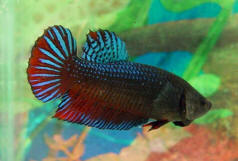BIO315 Laboratory Guide #2
BEHAVIORAL SAMPLING METHODS: THE SIMs,
JEWEL WASPS, AND ZOO CRITTERS

As preparation for this lab, read the following two references:
Lehner chapter
Altmann article
LAB 2A: THE SIMsTM
The first part of this laboratory will involve observing the behavior of a set of simulated people - specifically SIMs. The SIMs have the virtues of exhibiting a reasonable-sized set of recognizable and easily categorizable behaviors in a fairly fixed and controllable setting. The behaviors are fairly spontaneous, and there are enough probabilistic elements that the simulation will evolve differently each time we run it. Just when you think you have seen everything, someone will do something totally new and unexpected.
In the SIMs you will also encounter many of the problems of field behavioral observation. House furnishings will block your view of critical behaviors. Subjects will wander upstairs and out of view for indefinite periods of time. Many behaviors will be ambiguous and difficult to identify or classify. New subjects may "magically" appear from who-knows-where, and old subjects may change state - e.g. sleep or die.
You will use the SIMs to practice the behavioral sampling methods that we have discussed in class. In this simulation a family of SIMs, the Goth family, have invited a few of their friends and acquaintances over for a visit. By the addition of a strategic fence segment all of the members of this group have been trapped at the Goth house for your observation. We will run the simulation several times to practice the behavioral sampling methods which you studied in the Altmann article and Lehner chapter excepts, and which we discussed in class. Think of this as a warm-up and practice session for our upcoming zoo trip.
There are eight subjects in this study:
Bella Diane
Betty Jeff
Cassandra Melissa
Daniel Mortimer
Pass 1: ad lib sampling and ethogram: During the first run of the simulation we will collectively practice ad libitum sampling to establish an initial ethogram. Write down all of the behaviors which you observe. We will compile these into functional categories to serve as a reference ethogram for the class.
Pass 2: focal individual sampling and behavioral repertoire: During the second run you will focus on a specific individual. Record all of the behaviors that you see and keep track of repetitions. At the end of this run you should have enough data to produce an individual ethogram and produce an estimate q of the completeness of your ethogram.
q = 1 - (N1/I)
Pass 3: behavioral sequence sampling: During the third run you will look for and document behavioral sequences. Cooking, housecleaning, and personal hygiene activity are excellent for this.
Pass 4: sociometric matrix: During the fourth and final pass you will gather enough data to construct a sociometric matrix for either verbal on nonverbal interactions between SIMs. The dimensions of this matrix will be "Initiator" and "Responder". All eight SIMs will be listed on each axis. For verbal interactions, pay attention to the conversation balloons. The first SIM with a balloon is the "Initiator" and the second SIM is the "Responder". For nonverbal interactions, pay attention to gestures. Again the first SIM to gesture is the Initiator and the second is the Responder.
LAB 2B: JEWEL WASP MATING BEHAVIOR
The second part of this laboratory will involve observing courtship and mating sequences in a tiny, stingless, parasitoid wasp Nasonia vitripennis, commonly called the jewel wasp. The jewel wasp life cycle begins when a female wasp finds a suitable fly puparium to serve as a host and oviposits up to 40 eggs. After a very short time the wasp eggs hatch into larvae which consume the hapless living fly pupa within its puparium case. After 8-10 days the wasp larve pupate and after 8-10 more days they metamorphose into adults. The adults eclose by chewing their way out of the fly puparium case and almost immediately begin mating. Soon thereafter the females fly off in search of a new host puparium for the next generational cycle. Once the females are gone the flightless males simply wander pointlessly around a bit, then die.
Our wasps have been reared in the puparia of the blowfly Sarcophaga bullata. Because females generally only mate once, very soon after eclosion, you will have to harvest and isolate virgin females before they have had an opportunity to mate. The simplest way to do this is to remove the wasp pupae from the fly puparium a day or two before eclosion, then separate female and male wasp pupae into separate containers. Once the virgin wasps eclose into adults, they are ready to be used for one-on-one behavioral trials.
Step 1: Isolate virgin females and males into separate bottles. Female pupae may be most easily and reliably distinguished by the longer wing pads.
Female wing pads extend the full width of the thorax and may be seen from
the ventral surface of an upside-down wasp
Male wing pads are much shorter and smaller and are not visible in a ventral
view of an upside-down wasp
Since it is much more critical that our experimental females are virgins than that the males are virgins, sort any ambiguous wasp into the male pile (or discard it).
Step 2: Wait 2-3 days for the wasps to develop into adults. Adult males only last a few days. Adult female wasps may be kept alive for a week or more by smearing a thin streak of honey inside their bottle. However, it is best to use both males and females as soon after their transformation into adults as possible.
Step 3: Anesthetize male and female wasps on a CO2 bed, as demonstrated by the instructor. Wasps may be kept anesthetized for up to 10 minutes without harm.
Step 4: For simple viewing, use a brush to transfer 1 female and 1 male anesthetized wasp to a small Petri dish, cap the dish, and place in under a dissecting microscope. Focus on the female; the male will eventually come to her.
~OR~
For digital photography, center a small, square observation chamber on the camera stage, then focus and center the camera image. Transfer 1 female and 1 male anesthetized wasp to the chamber and cap it with a clean glass square. Begin recording when the female starts to move. A small square sheet of lavender paper makes a good photographic backdrop slide it under the chamber.
Step 5: Observe the sequence of both male and female behaviors as they interact in the courtship/mating process. It may take you 3-4 trials to identify and name all of the behaviors in the sequence.
Step 6: Repeat steps 4&5 until you have good sequence data for a total of at least five trials.
PLEASE CONSERVE CO2 BY CLAMPING OFF YOUR SUPPLY LINE WHENEVER YOU ARE NOT ANESTHETIZING WASPS.
BE SURE TO TURN OFF THE CO2 AT THE TANK WHEN YOU ARE THROUGH WITH YOUR SESSION.
LAB 2C: ZOO TRIP
Schedule: Friday, September 14
8:00 AM SHARP! Depart from Taylor Hall via school van
9:45 AM Arrive ZooAtlanta
9:45 11:00 AM Initial tour of zoo
11:00 AM 11:30 AM Discussion/choice of animals for observing
@ BURGER KING PLAZA
11:30 AM 1:00PM Observation Session 1 : Ethogram
1:00 1:30 PM Lunch @ BURGER KING PLAZA
1:30 PM 3:00 PM Observation Session 2: Sociometric Matrix
3:00 PM 3:15 PM Regrouping @ ENTRANCE PLAZA
3:15 PM Depart ZooAtlanta
~5:00 PM Arrive Wesleyan
During the observation periods you will produce 1) an ethogram and 2) a sociometric matrix of your observational subject(s).
WRITE-UP FOR THIS LAB
The writeup will include sections for the SIMS, for the jewel wasps, and for the zoo. Each section should include an appropriate introduction/background, methodology, presentation of results, and brief discussion. Specific results for the three sections should include:
A) SIMs:
1) class ethogram
2) focal individual behavioral list and tallies with estimate of completeness q
3) behavioral sequence samples
4) sociometric matrix of conversations
B) Wasps:
1) list of behavioral components for the male and for the female, with a brief description
of each
2) behavioral sequences for at least five mating episodes
C) Zoo:
1) ethogram for your first target species (does not have to include q)
2) sociometric matrix for your second target species group
(this may focus on a pair of individuals or a pair of behaviors)
